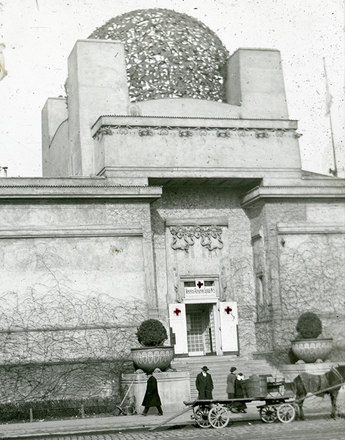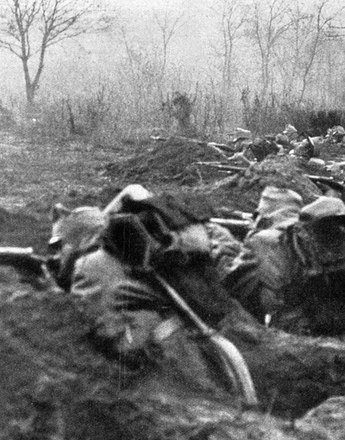The heroes behind the camera
The film reporters in the First World War, on whichever side they were, had the same problems to deal with: the production of authentic war pictures was difficult if not impossible. The cameras were heavy and cumbersome, telephoto lenses almost unknown, and the film material was not very light-sensitive, so that it was difficult if not impossible to film at dusk or in the night, when a lot of the fighting took place.
The War Press Office followed the propaganda activities of the allied German Reich and the enemy Entente very closely. Above all responses were needed for the ‘leader films’ by the enemy powers.
The British propaganda film The Battle of the Somme (GB 1916) left a lasting impression with the Central Powers. The shots had been taken for the most part at the battle site, and only a few scenes had been simulated. Dead soldiers were shown for the first time on film, and the pictures were authentic. The Battle of the Somme was seen in the German-speaking press as a ‘raw battle film’. Even so, the film was far from reality – a military disaster was skilfully presented as a victory.
Producers were fully aware of the impact of simulated scenes. In press releases the Austro-Hungarian film office proudly claimed that only ‘authentic material’ was used and that there were no staged shots. The film operators were presented as courageous heroes: ‘The film troupes, small, well-equipped units under the command of an officer, have the order to advance to the front line to film the action where it happens. … They film the fighting on the battlefield, even under enemy fire. The intrepid Austrian film operators often have to be expressly ordered by the battle commander to leave a particular spot so as to prevent enemy fire from being drawn to what is thought, in view of the unavoidably exposed position, to be a machine gun post. For that reason it is not uncommon for film operators to be lightly or severely wounded’ (Der österreichische Komet, no. 429, 1918).
The reality was usually different. Sascha Kolowrat soon realized that military action was far less impressive on film than in reality. He therefore decided to stage dramatic actions. For the passage of a machine gun platoon through a lakeland area he simulated enemy fire by setting off dozens of blank hand grenades. The splashes of water and the hail of mud falling on the packhorses looked more realistic than authentic pictures would have been. These pictures have unfortunately been lost.
But re-enactments of this type were not always successful. Experienced troop quickly recognized when the scenes were unreal. The film propaganda found itself in a dilemma. The soldiers were resentful when the cameramen avoided fire and just took pictures of the ‘easier life’ behind the lines. But the staged scenes sometimes caused the audience at the field cinemas to burst out laughing.
Fictional and non-fictional scenes were often mixed and could not be properly distinguished. The creators of these pictures, the film operators themselves, were rarely seen. In the film The Tenth Battle of Isonzo (A 1917) the men behind the camera appear briefly. The film excerpt shows the assembly of a cinematograph on warplane K 210 and a flight over Trieste. It also shows Gottfried von Banfield, a ‘real war hero’ – as he was presented in the media. He was commander from 1916 of the Trieste Seaplane Station, which flew missions attacking the Italian ports and the Isonzo front. He was one of the most successful pilots in the Austro-Hungarian army and was made a baron and awarded the Military Order of Maria Theresa for his military achievements.
Translation: Nick Somers
Krenn, Günter: Der bewegte Mensch – Sascha Kolowrat, in: Bono, Francesco/Caneppele, Paolo/Krenn, Günter: Elektrische Schatten. Beiträge zur österreichischen Stummfilmgeschichte, Wien 1999, 37-46
Rother, Rainer: Bei unseren Helden an der Somme. Eine deutsche Antwort auf die Entente-Propaganda, in: KINtop 4, Anfänge des dokumentarischen Films, Jahrbuch zur Erforschung des frühen Films, Basel/Frankfurt am Main 1995, 123-142







